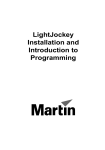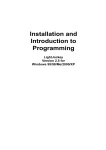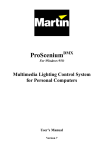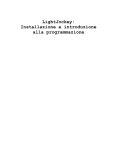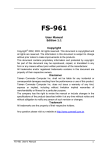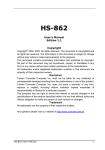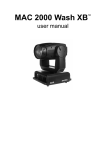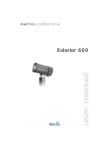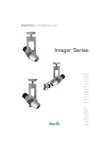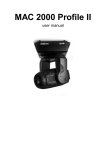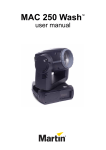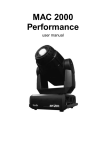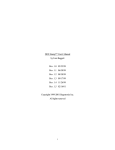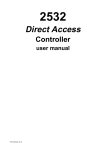Download Light Jockey user manual
Transcript
LightJockey: Installation and Introduction to Programming © 1998 Martin Professional A/S, Denmark. All rights reserved. No part of this manual may be reproduced, in any form or by any means, without permission in writing from Martin Professional A/S, Denmark. Printed in Denmark. P/N 510943 Revision #981119-MA Contents Hardware options ............................................................................................................... .............. 4 Select 4064 card memory address................................................................................................ .... 4 Installing the 4064 card....................................................................................................... ............. 5 Installing the Martin DMX ADP parallel port interface .................................................................. 5 Software installation .......................................................................................................... .............. 6 Configure hardware ............................................................................................................. ............ 6 Troubleshooting ................................................................................................................ ............... 6 Connecting the serial data link................................................................................................ ......... 8 Tips for building a trouble-free serial link.................................................................................. 8 Introduction to programming .................................................................................................... ....... 9 Identifying the controls ....................................................................................................... ............. 9 Main screen.................................................................................................................... ............. 9 Sequence toolbar............................................................................................................... ........ 10 Cue toolbar ............................................................................................................................... 10 Fixture toolbar .......................................................................................................................... 10 Configuring fixtures....................................................................................................................... 11 Example: Configure 2 MAC 600s ............................................................................................ 11 Configuring the desktop................................................................................................................. 12 Example: Place 2 MAC 600s on desktop ................................................................................. 12 Striking lamps ................................................................................................................................ 13 Example: Strike MAC 600s...................................................................................................... 13 Programming cues ......................................................................................................................... 14 Cue building blocks .................................................................................................................. 14 Bottom to top cue execution..................................................................................................... 14 Outline of programming steps .................................................................................................. 15 Creating new cues..................................................................................................................... 15 Creating and editing sequences ................................................................................................ 15 Selecting fixtures ...................................................................................................................... 16 Programming effects................................................................................................................. 16 Setting the Off/Snap/Fade control ............................................................................................ 16 Setting scene and fade times..................................................................................................... 17 Adding, inserting, and deleting scenes ..................................................................................... 17 Saving sequences ...................................................................................................................... 17 Adding sequences to a que ....................................................................................................... 18 Saving cues ............................................................................................................................... 18 Example: Programming a cue ........................................................................................................ 19 Program shutter/dimmer sequence ........................................................................................... 19 Add sequence to que................................................................................................................. 20 Program color sequence............................................................................................................ 21 Program movement sequence ................................................................................................... 24 Edit movement sequence .......................................................................................................... 26 Save the cue .............................................................................................................................. 28 Edit the cue ............................................................................................................................... 28 Additional cue operations .............................................................................................................. 30 2532 Direct Access Controller....................................................................................................... 30 3 Hardware options The LightJockey controller software comes bundled with hardware to enable DMX transmission to control DMX-512 fixtures from your PC. The LightJockey supports two types of hardware: an 8-bit ISA card and a parallel printer port interface. The hardware can be damaged by static electricity. Release static electric charges before handling the hardware by touching a grounded metal object, and always avoid touching sensitive electronic components. Note: the hardware must be configured within LightJockey before use. Select 4064 card memory address The 4064 card comes in two flavors - the 2048 DMX channel Club version and the 256 channel DJ version. The installation process is identical for both types. The 4064 card is a memory-mapped I/O device. Before installing the card, the occupation of the PC memory by different devices must be checked in order to verify the correct memory allocation for the card. 1. Right-click on "My Computer.". 2. Click on "Properties." 3. Click on "Device Manager." 4. Click on "Properties." 5. Click on "Memory." On screen is the list of memory assignments similar to the one shown to below. The 4064 card can use any available block in the "C" or "D" segments. 4 6. 7. 8. The factory default memory address for the 4064 card is D2000 (DIP-switch pins 2 and 5 on, all others off). If no other device is mapped to memory that includes the addresses from 000D2000 to 000D2FFF, then proceed to “Install card.” On Table 1 (page 5), cross out all occupied blocks in the C and D segments. For the assignments shown above, you would cross out blocks CO-C7 (000C0000 000C7FFF), block C8 (000C8000 - 000C8FFF), and block CA (000CA000 000CAFFF). Select any of the unoccupied memory blocks. Set the card’s DIP switch - located on the end opposite the mounting bracket - by flipping the pins indicated in Table 1 to the ON position. Installing the 4064 card 1. 2. 3. 4. 5. 6. 7. Turn off the computer and disconnect the power cord. Failure to unplug the cord could result in injury to you or damage to the computer. Remove the cover. Find an available ISA expansion slot. Remove its cover plate from the back of the computer chassis. Save the screw for fastening the DMX I/O card. Holding the card by the bracket and corner, push the card's copper contacts into the expansion slot. Fasten the card to the chassis. Replace the cover and reconnect the power cord. Connect the DMX output cable(s) to the card. There are 2 connectors on the Club version: The bottom connector has outputs for DMX links 1 and 2; the top output for DMX links 3 and 4. The DJ version has 1 connector supporting DMX in and output. Connect fixtures to the controller. The DMX output is compatible with the DMX512 standard. Installing the Martin DMX ADP parallel port interface The parallel port interface enables laptop and other PCs without an available ISA expansion slot to run the LightJockey. The interface supports up to 512 DMX channels on one link. It is not necessary to open the computer in order to install the hardware. As the parallel port does not deliver sufficient electrical current to supply the DMX transmission, the interface is equipped with a system that takes power from a keyboard or P/S2 mouse port. 1. 2. 3. Disconnect the PC and remove the power cord to avoid risk of injury. Insert the ADP interface body into the 25-pin parallel port and fasten it with the two screws. If the keyboard or PS/2 mouse port is not already in use simply connect the male PS/2 connector to the port (using the PS/2 to DIN adapter if required). 5 4. If the port is already in use by a peripheral, connect the male PS/2 connector to the port (using the PS/2 to DIN adapter if required). Then connect the peripheral to the female PS/2 connector of the ADP interface (again using the PS/2 to DIN adapter if required). 5. Connect fixtures to the controller. The DMX output is compatible with the DMX-512 standard. Software installation The LightJockey CD uses the Windows 95/98 tm auto-start to launch the setup program when the CD is inserted into the CD-ROM drive. If the Windows auto-insert notification is disabled, and the installation process does not start automatically, change to the Disk1 directory in the root directory of the CD-ROM. From there you must manually run the setup.exe program. To install on a PC without CD-ROM drive, copy the contents of the DiskX directories to individual 1.44 MB floppy disks. Insert the floppy disk with the Disk1 contents into the PC and run setup.exe. Once LightJockey has installed, start it by clicking on the LightJockey icon located in the programs folder in the Windows start menu. Configure hardware 1. 2. Select Setup from the main menu. Select Hardware from the dropdown menu and then click the Detect hardware button. LightJockey searches for available hardware and lists all hardware found. The search may take up to 20 seconds. 3. Select the relevant hardware by clicking on it in the list, then click OK. 4. Restart LightJockey when prompted. Troubleshooting If the LightJockey does not locate the ADP interface: • • Check that the interface is properly seated in the parallel port. Check if the status LED of the interface does turn on, if not that indicates that power is not supplied to the interface from the keyboard or PS/2 mouse port. • On certain PCs, especially laptops, it may be necessary to enable both the parallel port and the power supplying keyboard or PS/2 mouse port in order to use the DMX ADP. Please consult your PC documentation for details if the adapter fails to work. 6 If the LightJockey software does not locate the 4064 card: • • Disconnect the PC and make sure the card is correctly installed and seated in the ISA slot. Check that the correct DIP switches are ON, and that all other DIP switches are OFF. Block C0 C1 C2 C3 C4 C5 C7 C8 C9 CA CB CC CD CE CF Pins On Block None D0 1 D1 2 D2 1, 2 D3 3 D4 1, 3 D5 2, 3 D6 1, 2, 3 4 1, 4 D SEGMENT C SEGMENT C6 Address Range 000C0000 000C0FFF 000C1000 000C1FFF 000C2000 000C2FFF 000C3000 000C3FFF 000C4000 000C4FFF 000C5000 000C5FFF 000C6000 000C6FFF 000C7000 000C7FFF 000C8000 000C8FFF 000C9000 000C9FFF 000CA000 000CAFFF 000CB000 000CBFFF 000CC000 000CCFFF 000CD000 000CDFFF 000CE000 000CEFFF 000CF000 000CFFFF D7 D8 D9 2, 4 DA 1, 2, 4 DB 3, 4 DC 1, 3, 4 DD 2, 3, 4 DE 1, 2, 3, 4 DF Address Range 000D0000 000D0FFF 000D1000 000D1FFF 000D2000 000D2FFF 000D3000 000D3FFF 000D4000 000D4FFF 000D5000 000D5FFF 000D6000 000D6FFF 000D7000 000D7FFF 000D8000 000D8FFF 000D9000 000D9FFF 000DA000 000DAFFF 000DB000 000DBFFF 000DC000 000DCFFF 000DD000 000DDFFF 000DE000 000DEFFF 000DF000 000DFFFF Pins On 5 1, 5 2, 5 1, 2, 5 3, 5 1, 3, 5 2, 3, 5 1, 2, 3, 5 4, 5 1, 4, 5 2, 4, 5 1, 2, 4, 5 3, 4, 5 1, 3, 4, 5 2, 3, 4, 5 1, 2, 3, 4, 5 MAC 600 CMY pan cue structureDIP-Switch Settings 7 Connecting the serial data link The pin-out of the 3-pin DMX connectors is compatible with the DMX-512 standard, i.e., pin 1 to shield, pin 2 to cold (-) and pin 3 to hot (+). As some devices have 5pin connectors, or 3-pin connectors with reversed polarity on pins 2 and 3, the following adaptor cables may be required. 5-pin to 3-pin Adaptor 3-pin to 5-pin Adaptor 3-pin to 3-pin Phase-Reversing Adaptor Male Female Male Female Male Female 1 2 3 4 5 1 2 3 1 2 3 1 2 3 4 5 1 2 3 1 2 3 P/N 309160 Construct P/N 309158 1. Connect the controller’s output to the first fixture’s data input. For a DMX fixture with 5-pin input, construct a cable with a 3-pin male and a 5-pin female connector. For a DMX fixture with 3-pin input, use a regular cable with 3-pin male and female connectors. For a Martin RS-485 protocol fixture, use a phase reversing cable with 3-pin male and female connectors such as P/N 309158. 2. To connect additional fixtures, connect the output of the fixture closest to the controller to the input of the next fixture. When connecting a DMX fixture to a Martin fixture with pin 3 cold (-), use a 3-pin phase-reversing adaptor such as Martin P/N 309158. 3. Terminate the link. Insert a male 120 ohm XLR termination plug in the output of the last fixture on the link. The termination plug, which is simply a male XLR connector with a 120 ohm, 0.25 watt resistor soldered between pins 2 and 3, “soaks up” the control signal so it does not reflect back down the link and cause interference. Tips for building a trouble-free serial link • Use shielded twisted-pair cable designed for RS-485 devices. Standard microphone cable is not designed for use in serial links and often causes unpredictable performance. • Never use a “Y” connector to split the link. To split the serial link into branches use a splitter such as the Martin 4-Channel Opto-Isolated RS-485 Splitter/Amplifier. If a splitter/amplifier is used, terminate each branch of the link. • Do not overload the link. Up to 32 devices may be connected on a serial link. If a splitter/amplifier is used, up to 32 devices may be connected on each branch. 8 Introduction to programming The rest of this guide will help you start programming the Martin LightJockey controller. It explains the features you need to get started; additional information about the controller is available in the on-line Help. As you go through this introduction, concentrate on the Off/Snap/Fade control and how it relates to the way sequences execute. If you have programmed with the Martin 3032, you will find the LightJockey similar in many ways. Fade times and the Off/Snap/Fade control, however, will be new to you. This guide assumes that you are familiar with Windows. As you experiment with the controls, be aware that clicking with the left and right mouse buttons often does different things. Identifying the controls Depending on software version, screens and buttons may differ from those shown here. Main screen Main menu Seq & Cue Toolbars Cuelist Toolbar Fixture Toolbar Page tabs Fixture icons Control windows Status bar 9 Sequence toolbar 1 1. 2. 3. 4. 5. 6. 2 3 4 5 6 Sequence name field View Sequence Control button New/Clear Sequence button Save Sequence button List of Sequences button Scene number field (current scene : total scenes) Cue toolbar 1 2 3 4 5 1. Cue name field 2. View Cue Control button 3. New/Clear Cue button 4. Save Cue button 5. List of Cues button Fixture toolbar 1 2 3 4 5 6 7 8 9 1. 2. 3. 4. 5. 6. 7. 8. 9. 10. 11. 10 Intensity button Movement button Color button Gobo button Beam button Effect button Levels/Special button Lamp button Reset button Show Fixture Controls button Fixture Groups button 10 11 Configuring fixtures The first step after setting up the hardware is to select and address your lighting fixtures in the Fixture Configuration window, which you open by choosing Setup > Fixture Configuration from the main menu. Example: Configure 2 MAC 600s 1. 2. 3. 4. 5. Choose Setup > Fixture Configuration from the main menu. Select “MAC 600 (mode 2/4)” from the list of Available Fixture Types. Drag and drop it on line 1. Add another to line 2. Click Auto Address. Click Find Addresses and then click OK. Addresses can also be set manually in the DMX Address field at the bottom of the screen. Either way, the mode and address settings of the actual fixtures must match the LightJockey’s fixture configuration. Click the first MAC 600. Type “Left” in the Fixture Username field at the bottom of the screen. Click the second MAC 600 and name it “Right.” Save the configuration and close the window. 11 Configuring the desktop Lighting fixtures are represented by icons on screen. To create and place icons, you drag fixtures from the Unassigned Fixtures list to the desktop. Icons may be organized any way you like on multiple pages or “tabs.” Menus for arranging the desktop and icons, etc., pop up if you right-click on the desktop and icons. Example: Place 2 MAC 600s on desktop 1. 2. 3. 12 The list of unassigned fixtures is displayed on the desktop automatically. If you closed it, reopen the list by selecting View > Unassigned Fixtures from the main menu. Drag the MAC 600s from the list to the desktop. Right-click on the desktop. Select Icons > Auto Arrange. Click OK. Striking lamps Most Martin fixtures with discharge lamps, also known as arc lamps, must be struck (turned on) from the controller. There are three ways to do this: • Use the LightJockey’s automatic lamp-strike feature. This is recommended and is described in the following example. • Program a “lamp on” cue. This is not recommended because Martin fixtures use the same DMX channel for lamp and shutter control. The lamp-on command will be overridden by any higher-priority sequence with a shutter command. If you choose to program a “lamp on” cue, turn on the lamps one at a time with 3 - 5 second intervals to avoid excessive voltage drop and current draw. • Strike a lamp manually by selecting it, clicking the Lamp button on the fixture toolbar, and clicking Power On in the Lamp Control dialog. Depending on the fixture, the Lamp Control may also allow you to turn off the lamp. Example: Strike MAC 600s 1. 2. 3. 4. Configure 2 MAC 600s and place them on the desktop. Setup the fixtures for operation in mode 4 as described in the MAC 600 user manual. Choose System > Auto Strike Lamps from the main menu. Click Stop after the LightJockey has been through the cycle once or twice and the lamps have struck. 13 Programming cues Cue building blocks A light show is typically divided into cues that you program and then play back from the list of available cues. The LightJockey also supports cue playback from the Martin 2532 Direct Access Controller, which is available as an accessory. A cue points to up to 12 sequences that all run together at the same time, i.e., in parallel. A sequence is made up of scenes. Scenes run one after the other, i.e., in sequence, and can have different lengths (scene times). Later on you will program a cue with 3 sequences. The sequences have 1, 3, and 2 scenes, respectively, with scene times as shown below. With the default loop settings, once a sequence finishes, it loops back to the start and repeats for as long as you play the cue. Seq. 1 2 3 Scene action, number and time * *Open shutter. Open dimmer 20% (1 s) 1:1 C in, Y out 1:3 (3 s) M in, C out 2:3 (3 s) Y in, M out 3:3 (3 s) Fast pan 1:2 (2 s) Slow pan 2:2 (15 s) MAC 600 CMY pan cue structure Bottom to top cue execution It is essential that you understand how sequences are executed within a cue. Picture it as if the LightJockey takes effects one at a time and looks for instructions at the bottom of the cue. If the effect’s Off/Snap/Fade control is set to Snap or Fade, the controller executes the instructions in the sequence and then moves to the next effect. If the effect’s control is Off, it looks for instructions in the next higher sequence. The LightJockey continues up the cue until it finds a Snap or Fade command. If an effect is programmed in two sequences at the same time, the controller executes the instruction closer to the bottom. If an effect does not behave as predicted it is probably being controlled by a sequence lower in the cue. In the example cue that follows, you open the shutter in the “20% dimmer” sequence - the top sequence - and close it in scene 1 of the “Pan” sequence - the bottom sequence. Sequence 3 has priority so the shutter closes during scene 1 and opens again in scene 2, where the shutter control is Off. If you move “20% dimmer” below “Pan,” however, “20% dimmer” has priority and the shutter stays open all the time. 14 Outline of programming steps The basic steps for programming a cue are outlined below and explained in more detail in the following sections. I. Create new cue. II. Program up to 12 sequences. A. Create new sequence. B. Program up to 999 scenes. 1. Add scene. (Scene 1 is added automatically.) 2. Program fixtures. Repeat as necessary. a) Select fixtures. b) Set desired effects. c) 3. III. Set effects to snap or fade. Set fade and scene time. C. Save sequence. D. Add sequence to cue. Save cue. Creating new cues To program a cue you can either create a new one or load an existing one onto the desktop using Windows techniques such as dragging and dropping. The cue on the desktop is called the current cue. Click the New/Clear Cue button on the Cue toolbar to create a new cue and clear the current one. A gray Cue name field indicates a new (empty) cue. It turns yellow when a sequence has been added to the current cue. The action of the current cue is dynamically represented in the control windows. The pan/ tilt cursor, for instance, moves back and forth to show a pan movement. This allows you to see the effects of your programming without actual fixtures. Creating and editing sequences Just like cues, you program sequences by creating new ones or loading existing ones onto the desktop. The sequence on the desktop is known as the current sequence. To create a new sequence and clear the current one, click the New/Clear Sequence button on the Sequence toolbar . The Sequence name field changes from yellow to gray to indicate a new sequence; it turns yellow as soon as an instruction is programmed. 15 To edit an existing sequence, drag it from the List of Sequences to the desktop. Save changes by clicking “Save Sequence” instead of “Save as New Sequence” in the save dialog. The action of the current sequence is displayed differently from the action of the current cue. The controls for effects programmed in the current sequence do not move. This is to make programming easier. The pan/tilt cursor, to take the previous example, stops moving when you load the movement sequence onto the desktop. To “see” the sequence run, add it to the current cue and clear it from the desktop. Selecting fixtures Fixtures must be selected before they can be programmed. The icon caption field is light or dark red when a fixture is selected and blue when it is not selected. Click on fixture icons to select and deselect them. If you want to program a group of identical fixtures, say 2 MAC 600s, to do exactly the same thing, you can select and program them together. When you want to program fixtures to do different things, you must select and program them individually. (The effects generator is a little different.) Of course you can program some effects together and some effects individually. Usually, you will program fixtures of different types separately, but some effects, such as pan and tilt, may be programmed at the same time. Programming effects You control and program effects using slide bars, palettes, buttons, etc., in the fixture control windows, which graphically represent each effect. Control windows are opened and closed using the buttons on the Fixture toolbar. There is an individual button for each control window as well as a master “Show Fixture Controls” button that opens and closes all the commonly used control windows. Once open, the windows may be dragged anywhere on screen. Setting the Off/Snap/Fade control Most controls have an Off/Snap/Fade (O/S/F) button. Some controls, such as Lamp Control, have Off and Snap only. In the default setting, the button is red and “Off”. One click makes it a yellow “Snap” button. Two clicks makes it a green “Fade” button. Leave the button on Off (the default) unless you are programming a command. When an effect’s O/S/F button is Off, the control sends no instructions, allowing a lower-priority sequence to control the effect. Click the O/S/F button to Snap to move the effect at maximum speed. Click the O/S/F button to Fade to fade the effect in or out using the fade time. 16 Setting scene and fade times A scene lasts for a period of time known as the scene time. Fade time is the period of time over which an effect moves if its Off/Snap/Fade control is set to Fade. (If the control is set to Snap, the effect changes “instantly” at maximum speed.) Scene and fade times are entered in the Sequence Control dialog, which is shown below. Adding, inserting, and deleting scenes A sequence can have anywhere from 1 to 999 scenes. Scenes are added, inserted, or deleted by clicking buttons in the Sequence Control dialog. Add Scene Insert Scene Delete Scene Current Scene Total Scenes Saving sequences Sequences are named and saved using the Save Sequence dialog. The dialog also has several check boxes that can be selected to speed up programming. Select “Save Sequence” to save changes to an existing sequence or “Save as New Sequence” to create a new sequence from the current sequence. 17 Adding sequences to a que Windows techniques such as drag and drop can be used to add, delete, and rearrange items in LightJockey lists. One way to add a sequence to a cue is to open the list of available sequences (click List of Sequences on the Sequence toolbar), open the Cue control window (click View Cue Control on the Cue toolbar), and drag the sequence to the desired position in the cue. See also “Add sequence to que” on page 20. Saving cues Cues are named and saved using the Save Cue dialog. Click Save Cue on the Cue toolbar or in Cue control dialog to open the Save Cue dialog. Click Save to save changes to an existing cue or Save New to create a new cue. 18 Example: Programming a cue This example demonstrates the steps, concepts, and displays involved in programming. It is designed to be programmed “blind” without fixtures attached. The screen shots show how your screen should look if you follow the steps correctly. Note, though, that the color palette is hidden in the Colors control window and that Show Special is disabled in the Intensity Control window. These options are selected in the windows’ Preferences menu. Step I: Program shutter/dimmer sequence In this step you program a sequence to open the shutters and set the dimmers to 20%. 1. 2. 3. 4. 5. Configure 2 MAC 600s and place them on the desktop if you have not done so. Locate the Cue name field on the Cue toolbar. Be careful not to confuse the Cue toolbar with the Cuelist toolbar. If the field is yellow, click New/Clear Cue. A new (empty) cue is indicated by a gray Cue name field. Locate the Sequence toolbar and click New/Clear Sequence if the Sequence name field is yellow. Click both MAC 600s to select them. The fixture icon caption is blue when the fixture is not selected and red when it is selected. Click Show Fixture Controls on the Fixture toolbar. Arrange the control windows any way like by dragging them on the desktop. Since you will not be using the Beam control in this example, close it to make more room on the desktop. Individual controls can be opened and closed as needed by clicking buttons on the Fixture toolbar. 6. Find the Intensity dialog. Place the mouse over the words “Shutter Closed” and click. Three things happen: “Shutter Closed” changes to “Shutter Open,” the shutter O/S/F button automatically changes to Snap, and the Sequence Name field in the Sequence toolbar changes from gray to yellow, indicating a change to the new sequence. 7. Drag the dimmer level (Intensity) to 20%. Click the dimmer O/S/F button twice to Snap. Shutter control Dimmer Off/Snap/Fade Dimmer level (% open) 19 8. 9. Verify that your Intensity control looks like the one above and that the O/S/F buttons in all other controls are off. Click Save Sequence in the Sequence toolbar. Type “20% dimmer” in the dialog’s Sequence Name field. Click Save as New Sequence or press Enter. Step II: Add sequence to que 1. 2. 3. Click List of Sequences on the Sequence toolbar. Click View Cue Control on the Cue toolbar. Be careful not to confuse the Cue toolbar with the Cuelist toolbar. Drag the “20% dimmer” sequence to position 1 in the cue. (If drag mode is not enabled, choose Preferences > Drag mode from the Select Sequence dialog menu.) The Cue name field changes from gray to yellow. Drag and drop sequences to cues. 20 Step III: Program color sequence The next sequence is a CMY (cyan, magenta, yellow) color chase with 3 scenes. In the first scene, cyan fades in and yellow, which comes in scene 3, fades out. In the second scene, cyan fades out and magenta fades in. Finally, magenta fades out and yellow fades in. The scene and fade times for each scene is set to three seconds for a smooth continuous effect. 1. 2. 3. 4. 5. 6. 7. Close the Cue control and sequence list windows. Click New/Clear Sequence on the Sequence toolbar. Make sure both MAC 600s are selected: a fixture is selected when the icon caption is either light or dark red. In the Color control, place the cursor over the cyan fader and drag it to 100%. The O/ S/F button automatically changes to Fade. Click View Sequence Control in the Sequence toolbar. Click the “Synchronize Scene and Fade Times” box. Set the scene (and fade) time to 3 seconds. Click Add Scene in the Sequence dialog. Add Scene Insert Scene Delete Scene Current Scene Total Scenes 21 8. Drag the Cyan fader to 0%. Drag the Magenta fader to 100%. 9. Click Add Scene in the Sequence dialog. 10. 22 Drag the Magenta fader to 0% and the Yellow fader to 100%. 11. Now you need to change scene 1 to fade out yellow. Scroll to scene 1 of 3 by clicking Next Scene (not Add Scene) in the dialog. Previous Scene 12. Next Scene Yellow is already at 0%; just click the O/S/F button for yellow to Fade. 13. 14. Click Save Sequence in the Sequence dialog or toolbar. Click the “Clear after Save” and “Add Sequence to Current Cue” boxes in the Save Sequence dialog. 15. Type “CMY chase” in the name field. 16. Click Save as New Sequence or press Enter to save, clear, and add the sequence to the current cue. Notice that the CMY faders move. 23 Step IV: Program movement sequence The LightJockey has a sophisticated effects engine for generating movements. This is described in detail in the on-line help. In this sequence you program each fixture individually to move in opposite directions. 1. Select the “Left” MAC 600 and deselect the “Right” MAC 600. 2. If the pan/tilt control window is not open, click Movement on the Fixture toolbar. 3. Drag the round white movement cursor to the middle of the top-right quadrant. Click the Pan O/S/F and the Tilt O/S/F buttons twice to Snap. 4. Click the “Left” MAC 600 to deselect it; select the “Right” MAC 600. 5. Drag the cursor to the middle of the top-left quadrant. 6. Click both Pan O/S/F and Tilt O/S/F to Snap. 24 7. Open the Sequence Control if it is closed by clicking View Sequence Control. Set the scene time to 2 seconds. Note: if the “Synchronize Scene and Fade Times” box is checked, then the Fade time will automatically be set to 2 seconds as well. Here it makes no difference because the effect is programmed to snap. 8. Click Add Scene in the Sequence dialog. Set the scene and fade times to 15 seconds. 9. Drag the cursor to the middle of the top-right quadrant. Click Pan O/S/F to Fade. 10. Click the “Right” MAC 600 to deselect it. Select the “Left” one. 25 11. Drag the cursor to the top-left quadrant and click Pan O/S/F to Fade. 12. Click Save Sequence on the Sequence toolbar. Type “Pan” in the Sequence Name field. Click Save as New Sequence or press Enter. The movement cursor should move slowly from left to right when you select the “Left” MAC 600 and from right to left when you select the “Right” one. Step V: Edit movement sequence Here you edit the pan sequence to black out both fixtures in the first scene. 1. 26 Click List of Sequences on the Sequence toolbar. 2. Drag the “Pan” sequence to the desktop. Close the sequence list. Notice that the cursor in the Movement control stopped moving and the name of the sequence is displayed in the Sequence name field. 3. Open the Sequence Control if it is closed. Click Next Scene to advance to scene 1. 27 4. Select both MAC 600s. Click the shutter control in the Intensity dialog. It changes from “Shutter Open” to “Shutter Closed.” Click, if necessary, to set the shutter O/S/ F button to Snap. 5. Click Save Sequence on the Sequence toolbar. Click Save Sequence (in the dialog) or press Enter. Click OK to confirm. Step VI: Save the cue Cues are handled much like sequences. 1. Click Save Cue on the Cue toolbar. 2. Type “M600 CMY pan” in the Cue Name field. 3. Click Save New or press Enter. Step VII: Edit the cue This step demonstrates how sequence order effects cue playback. Look at the Intensity control: the shutter closes for 2 seconds because of the command in the pan sequence. This sequence has the highest priority because it is closest to the bottom. When you put the 20% dimmer sequence underneath the pan sequence, the 20% dimmer sequence takes 28 priority and keeps the shutter open all the time. With a little planning, you can create different looks using the same sequences just by changing their order. 1. 2. 3. 4. 5. 6. 7. 8. 9. Click New/Clear Cue on the Cue toolbar to clear the cue from the desktop. (This is not required; it helps demonstrate how to load cues.) Click List of Cues on the Cue toolbar. Drag the “M600 CMY pan” cue to the desktop. Its name appears in the Cue name field and the cue begins to run. Close the list of cues to make room on the desktop. Click View Cue Control on the Cue toolbar. Drag the “20% dimmer” sequence from position 1 to position 4. Select Move Sequence from the pop-up dialog. Click Save Cue in the Edit Cue window. Click Save. Click OK in the confirmation dialog. Look at the Intensity control: the shutter now stays open all the time. 29 Additional cue operations When editing cues, the current sequence has highest priority. Normal cue execution resumes when the current sequence is cleared. Note too that to synchronize the sequences in the current cue, you must clear the cue and reload it onto the desktop. • • • To create a new cue and/or clear the current one, click New/Clear Cue. To load a cue, click List of Cues and drag it from the List of Cues to the desktop. Click View Cue Control to open the Edit Cue window. Here, sequences can be added, removed, rearranged, loaded, etc. To adjust cue timing, open the Cue Edit window and click Cue Times at the bottom. The cue master fader adjusts times (as a percent) for all sequences set to “CUE” time. Setting a sequence fader to another value overrides the master cue fader. 2532 Direct Access Controller The LightJockey supports the Martin 2532 Direct Access Controller, which can be used to play back cues and sequences. 1. 2. 3. 4. 30 Connect the 2532 to a serial (COM) port on the LightJockey computer. Apply power to the 2532. Choose Setup > Hardware Setup > Direct Access and select the COM port. Click Direct Access on the fixture toolbar to open the 2532 Direct Access window. For more information see the on-line help.






























